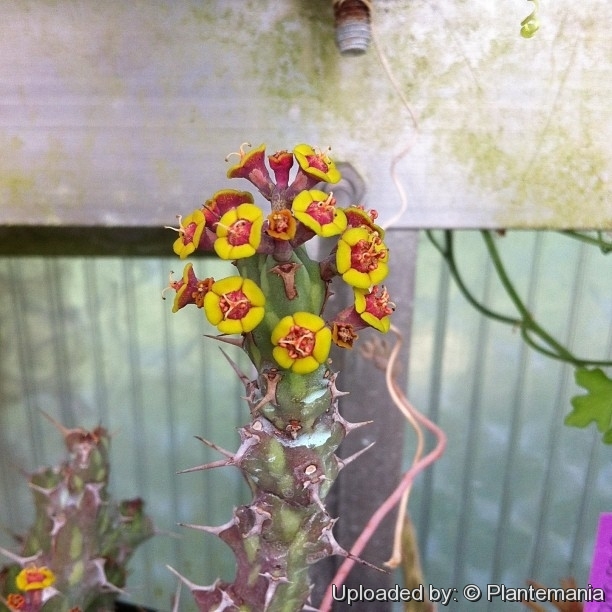




Your support is critical to our success.

Origin and Habitat: Somalia, NE Kenya near the Ethiopian border and SE Ethiopia.
Altitude range: 150–1000 metres above sea level.
Habitat and ecology. Euphorbia actinoclada grows on gravelly slopes with loose bushes. In Somalia it grows in open areas in low limestone outcrops in an otherwise rather well-vegetated Acacia and Commiphora bushland area. The plants grows mostly in the filtered shade of low shrublets and in close association with Euphorbia gymnocalycioidesSN|14187]]SN|14187]] and Euphorbia glochidiata.
Synonyms:
- Euphorbia actinoclada S.Carter
Description: Euphorbia actinocladaSN|32373]]SN|33404]] is a dwarf spiny, perennial, succulent shrublet up to 50 cm in diameter and 15 cm tall, but usually smaller, with a fleshy root merging into a short thick rootstock (often called a caudex). The upright branches are up to 15 cm long and 1 cm in diameter and spread in the upper part. Their surface is dark green with brighter longitudinal stripes. The flowers (cyathia) are reddish. The first description was published by Susan Carter Holmes in 1982.
Rootstock: The fleshy root merge into a short, mostly underground stem, to 5 cm high and 2 cm thick, branching from the tip just above ground level.
Roots: Secondary roots fibrous.
Branches: Tufted, simple, radiating from the apical growing-point, terete, slightly pentagonal in cross-section to 15 cm long or rarely 30 cm, 0.8-1 cm thick, with shallow pointed teeth to 1.5 cm apart in 5 loosely spiral series, glabrous, dark green with paler stripes between the teeth.
Spine-shields: Elongated, slender, 5–10 mm long, 1.5 mm wide, brownish-grey, quite separate. Spines single grey-brown, to 2 cm long. Stipular spines 2–3 mm long.
Leaves: The leaves of Euphorbia actinoclada are rudimentary and short-lived.
Inflorescences: Cymes solitary, subsessile (peduncle c. 1 mm long), simple with subsessile cyathia.
Flowers: Cyathia 4 mm in diameter. Nectar glands 1.75 mm broad, touching, reddish. Ovary sessile; styles 1.75 mm long.
Related species: E. actinoclada is closely related to Euphorbia triaculeata, but with much smaller branches from the centre of the crown and different red cyathia. It is also similar to Euphorbia kalisanaSN|33404]]SN|32373]].
Bibliography: Major references and further lectures
1) “Flora Somalia”, Vol 1, 1993 S. Carter (Euphorbia, Monadenium), M. G. Gilbert (Acalypha, Andrachne, Antidesma, Bridelia, Caperonia, Cephalocroton, Chrozophora, Clutia, Dalechampia, Flueggea, Givotia, Manihot, Meineckia, Micrococca, Oldfieldia, Phyllanthus, Ricinus, Suregada, Tragia), and M. Thulin (Croton, Drypetes, Erythrococca, Excoecaria, Jatropha, Spirostachys and Thecacoris) [updated by M. Thulin 2008]
2) “Cactus and Succulent Journal”, Volume 76, 2004
3) “Hooker's Icones Plantarum or Figures, with brief Descriptive Characters and Remarks of New or Rare Plants”. Volume 39, number 3, 1982, table 3851.
4) Volker Buddensiek “Sukkulente Euphorbien”. Ulmer, 1998
5) Urs Eggli “Illustrated Handbook of Succulent Plants: Dicotyledons” Volume 2. Springer, 2002
Cultivation and Propagation: This specie has the fame to be quite tricky to cultivate. A very very light and warm place is highly appreciated, but full sun all day long stops the growth, which is not resumed very easily and will lead to the loss of the plant.
It does best in a mineral soil, good drainage is essential. Water sparingly during the summer months and keep dry in winter. In the short growing season it likes ample water and in this period it grows rather quickly, though not for a long time. When not in growth, Euphorbia actinocladaSN|33404]]SN|33404]] is killed right away, when given too much water. It is a slow growing long lived plant and once established, it will be content in its position and with its soil for years. It can tolerate moderate shade, and a plant that has been growing in shade should be slowly hardened off before placing it in full sun as the plant will be severely scorched if moved too suddenly from shade into sun.
Propagation: It is propagated from seed sown during spring or summer. Germination occurs within 3 weeks. Sowing seed of this self fertile species is the surest method of growing typical offspring and seedlings are in the first season relatively easy to grow. It can be reproduced by cuttings or grafting as well but often lateral branches fail to produce the characteristic thick main stem.
| Your Actions | |
|---|---|
| Back to Euphorbia index | |
| Back to Euphorbiaceae index | |
 |
Back to Succulents Encyclopedia index |
Privacy stantement - Terms and conditions - How to cite - About us - Feedback - Donate



